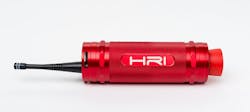Humanistic Robotics, Inc. specializes in wireless machine communications, and its Wireless E-Stop shuts down industrial equipment at the push of a button. No one can predict what will happen when MegaBots' Eagle Prime and Suidobashi Heavy Industries' Kuratas, so having an off switch could defineitly come in handy. We asked HRI spokesperson Bonnie Friel how it works.
NED: How did you come into contact with MegaBots?
HRI: We saw an early Megabots video and were excited about it. Of course we thought it was really cool, but we also saw the potential safety challenges. We wanted to work with them to make the battles as safe as possible. So we reached out to offer our hardware and our expertise in industrial safety to help make the project a success
NED: What safety equipment of your is used on the Mk. III and how does it work?
The Mk.III uses our Wireless Emergency Stop (WES) System. Essentially, it's a handheld button that can shutdown the entire system instantly and safely from a distance. With the WES, an operator can be outside of the robot with a good view of the entire "battlefield." If something dangerous should occur, they can stop the robot with the push of a button.
Hopefully, they'll never have to use that button. But with machines this large and powerful, and with so many spectators and technicians onsite, it's essential to have rigorous safety measures in place.
NED: What makes them bullet-proof?
HRI: HRI actually has a background in military applications, and we bring military-grade durability to our industrial products so they can function in tough environments.
The E-Stop operates with our proprietary SafetySense technology to ensure that the "stop" command will go through no matter what. When the stakes are this high, you can't afford to use a commercial, garage door-type remote control; it's too unreliable. The transmitter and receiver need to be in constant, two-way communication with one another. So we developed a robust, ultra-reliable wireless protocol to make sure shutdown will take place instantly.
NED: In manufacturing/industry, what are some common uses?
HRI: We have customers using the Wireless E-Stop for all kinds of industrial applications: auto and aerospace manufacturing, metal fabrication, automated warehousing, mobile heavy equipment, and many more.
The WES is used to shut down assembly lines, robotic cells, and large machine systems from one or more safe observation points. It also protects workers when they need to be near dangerous equipment in setup or maintenance scenarios. Essentially, any machine that has an emergency stop button can integrate the Wireless E-Stop as an additional safety component. It's especially useful for scenarios where the machine is mobile or the operator needs to be mobile.
As industrial systems become more automated, mobile, and interactive, the need for industrial safety is growing. Even the most advanced automated system isn't perfect… our approach is to provide that last line of defense to ensure that all workers are safe around these otherwise dangerous machines.
NED: What other support/ advice have you given to MegaBots?
HRI: We've provided technical support to make sure the E-Stop is installed and functioning properly. We're also working to equip the Megabots team with our next-generation Wireless E-Stops for the future.
NED: What does this giant robot battle mean to you and the rest of HRI?
We're excited to see American robotics in the spotlight. We hope that it will encourage people to think not just about the power of these robots, but of how we can make the human-machine relationship better and safer for everyone. That's what our whole company is about.












